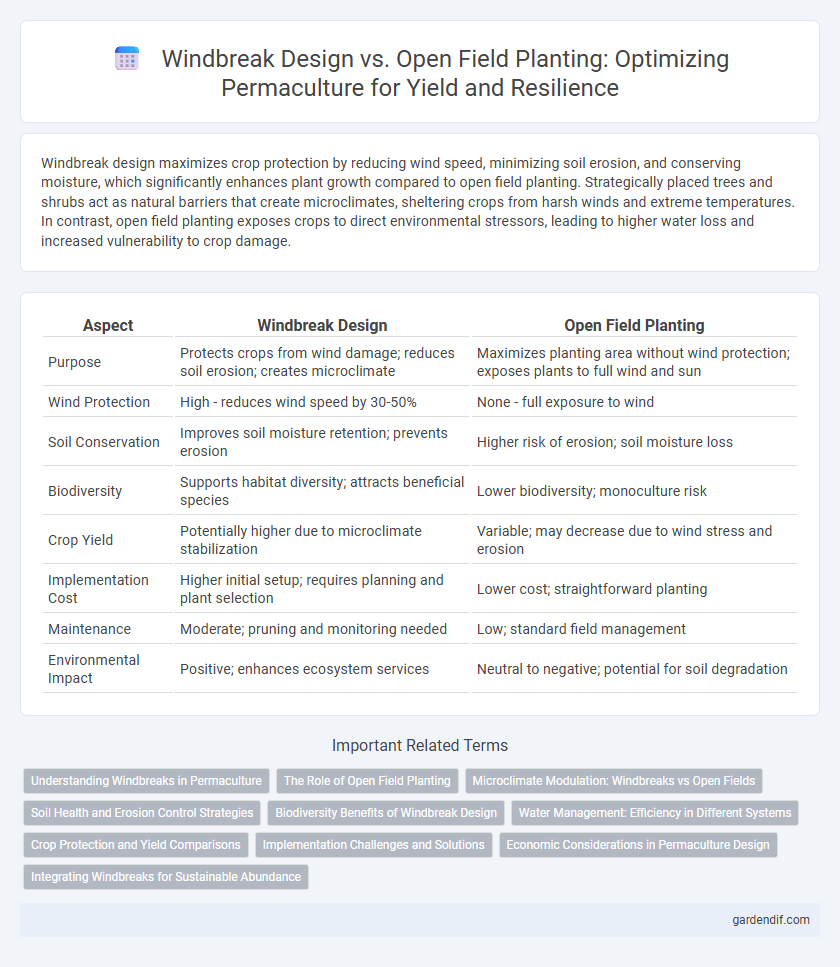
Windbreak Design vs Open Field Planting Illustration
Windbreak design maximizes crop protection by reducing wind speed, minimizing soil erosion, and conserving moisture, which significantly enhances plant growth compared to open field planting. Strategically placed trees and shrubs act as natural barriers that create microclimates, sheltering crops from harsh winds and extreme temperatures. In contrast, open field planting exposes crops to direct environmental stressors, leading to higher water loss and increased vulnerability to crop damage.
Table of Comparison
| Aspect | Windbreak Design | Open Field Planting |
|---|---|---|
| Purpose | Protects crops from wind damage; reduces soil erosion; creates microclimate | Maximizes planting area without wind protection; exposes plants to full wind and sun |
| Wind Protection | High - reduces wind speed by 30-50% | None - full exposure to wind |
| Soil Conservation | Improves soil moisture retention; prevents erosion | Higher risk of erosion; soil moisture loss |
| Biodiversity | Supports habitat diversity; attracts beneficial species | Lower biodiversity; monoculture risk |
| Crop Yield | Potentially higher due to microclimate stabilization | Variable; may decrease due to wind stress and erosion |
| Implementation Cost | Higher initial setup; requires planning and plant selection | Lower cost; straightforward planting |
| Maintenance | Moderate; pruning and monitoring needed | Low; standard field management |
| Environmental Impact | Positive; enhances ecosystem services | Neutral to negative; potential for soil degradation |
Understanding Windbreaks in Permaculture
Windbreak design in permaculture enhances microclimates by reducing wind speed, preventing soil erosion, and improving plant productivity compared to open field planting. Strategically placed rows of trees and shrubs create barriers that protect crops from harsh winds, conserve moisture, and increase biodiversity. Effective windbreaks optimize energy flow and support sustainable land management practices essential for resilient permaculture systems.
The Role of Open Field Planting
Open field planting in permaculture maximizes sun exposure and air circulation, promoting healthy plant growth and reducing humidity-related diseases. This approach supports diverse crop arrangements that take full advantage of natural wind patterns for pollination and pest control. Strategically integrating open fields with windbreaks enhances ecosystem resilience by balancing protection with environmental exposure.
Microclimate Modulation: Windbreaks vs Open Fields
Windbreaks create sheltered microclimates by reducing wind speed, which conserves soil moisture, minimizes erosion, and protects crops from temperature extremes, enhancing plant growth and productivity. In contrast, open field planting exposes crops to full wind exposure, increasing evapotranspiration and stress on plants, often leading to reduced yields in harsh climates. Strategic placement of multi-layered windbreaks using native species optimizes microclimate modulation, promoting biodiversity and sustainable permaculture systems.
Soil Health and Erosion Control Strategies
Windbreak design enhances soil health by reducing wind velocity, which minimizes topsoil erosion and conserves moisture critical for plant growth. In contrast, open field planting exposes soil to direct wind impact, increasing erosion risk and nutrient loss, leading to degraded soil structure. Implementing strategically placed windbreaks comprising diverse vegetation improves soil stability and supports long-term fertility compared to unprotected open fields.
Biodiversity Benefits of Windbreak Design
Windbreak design enhances biodiversity by providing diverse microhabitats that support various wildlife species, including beneficial insects, birds, and soil organisms, which are often absent in open field planting. These structured plantings improve ecosystem resilience by reducing soil erosion, increasing moisture retention, and creating corridors for species movement. The layered vegetation in windbreaks also promotes pollination and pest control, fostering a balanced and sustainable permaculture environment.
Water Management: Efficiency in Different Systems
Windbreak design enhances water management efficiency by reducing wind speed, which minimizes soil evaporation and conserves moisture, unlike open field planting where exposed soil experiences higher evaporation rates. Integrating trees or shrubs as windbreaks creates microclimates that improve soil moisture retention and promote deeper root water uptake. This strategic vegetation layout supports sustainable water use, crucial in permaculture systems aiming for resilient and productive landscapes.
Crop Protection and Yield Comparisons
Windbreak design in permaculture significantly enhances crop protection by reducing wind erosion, minimizing moisture loss, and shielding plants from physical damage, which directly contributes to higher and more consistent yields compared to open field planting. Studies show that windbreaks can increase crop productivity by up to 20-30% due to improved microclimatic conditions, such as moderated temperatures and reduced evapotranspiration. In contrast, open field planting exposes crops to harsher environmental stressors, often resulting in lower yields and increased vulnerability to pests and soil degradation.
Implementation Challenges and Solutions
Windbreak design in permaculture effectively mitigates wind erosion and microclimate extremes but presents implementation challenges such as selecting appropriate species, ensuring optimal spacing, and managing maintenance requirements. Open field planting offers simplicity and ease of mechanization but often exposes crops to wind stress and soil degradation, reducing overall productivity. Solutions include integrating multi-layered windbreaks with nitrogen-fixing plants and utilizing contour planting techniques to enhance soil stability and crop resilience.
Economic Considerations in Permaculture Design
Windbreak design in permaculture enhances microclimates, reducing crop damage and increasing yield stability, which lowers economic risks compared to open field planting. Strategic windbreaks improve water retention and soil fertility, cutting irrigation and fertilization costs over time. Although initial investment in windbreak establishment may be higher, the long-term economic benefits include higher biomass production and reduced crop loss that boost overall farm profitability.
Integrating Windbreaks for Sustainable Abundance
Integrating windbreaks into permaculture systems enhances microclimates by reducing wind erosion and moisture loss, promoting healthier soil and higher crop yields compared to open field planting. Strategic placement of diverse, multi-layered windbreaks supports biodiversity, stabilizes temperature, and conserves water, driving sustainable abundance in agricultural landscapes. These natural barriers improve energy efficiency and resilience, creating a balanced ecosystem that sustains productivity over time.
Windbreak Design vs Open Field Planting Infographic

 gardendif.com
gardendif.com